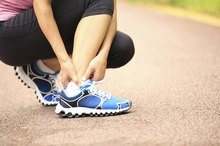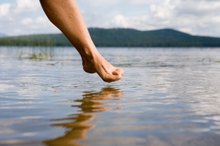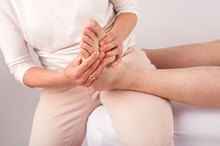Exercises For Sesamoiditis
Sesamoiditis is a foot ailment that causes pain on the ball of the foot beneath the big toe. It is so called because of the sesamoid bones, which are tiny bones in the tendons of the big toe. Sesamoiditis is usually due to overuse and is not serious. Rest, ice, over-the-counter pain medication and the use of cushioned footwear is usually recommended. Gentle exercises to increase range of motion and strengthen the foot may also be helpful.
Toe Crunches
Toe crunches help restore movement to the big toe after the pain and inflammation have subsided. Sit in a chair and place a hand towel on the floor beside your affected foot. Use the toes of your injured foot to grab and pick up the towel and then release it. Perform this exercise 10 times daily or as directed by your doctor.
- Toe crunches help restore movement to the big toe after the pain and inflammation have subsided.
- Use the toes of your injured foot to grab and pick up the towel and then release it.
Simple Range of Motion
How to Increase Flexibility in My Big Toes
Learn More
It's common to lose range of motion when there has been inflammation, which there often is with sesamoiditis. As the inflammation subsides, simple toe stretches can help restore mobility. Sit comfortably and extend the leg of your affected foot. Using just your foot muscles, curl your big toe under and then pull it back toward you. Start with smaller motions and work up to exaggerated motions. Stop if there is any pain. Do this exercise 10 to 20 times daily or as directed by your doctor.
- It's common to lose range of motion when there has been inflammation, which there often is with sesamoiditis.
- Using just your foot muscles, curl your big toe under and then pull it back toward you.
Foot Raises
This exercise should be performed only when your pain and inflammation have completely subsided and your doctor has given you the go-ahead. Stand upright and simply rise up on to your toes. Hold the lift for two counts and then lower back down. Repeat 10 to 15 times daily or as directed by your doctor.
- This exercise should be performed only when your pain and inflammation have completely subsided and your doctor has given you the go-ahead.
Considerations
Ankle Tendinitis Symptoms and Treatment
Learn More
In most cases, rehabilitative exercises are not necessary unless your doctor recommends them. After resting your foot for a period of time, applying ice and wearing appropriate footwear, pain and swelling should go away and you can resume normal activity. In some cases, it may be helpful to wrap your foot in a supportive elastic bandage for a time when returning to your activities. If your pain recurs or is chronic, speak to your doctor about other treatment options.
- In most cases, rehabilitative exercises are not necessary unless your doctor recommends them.
- After resting your foot for a period of time, applying ice and wearing appropriate footwear, pain and swelling should go away and you can resume normal activity.
Related Articles
References
- American Academy of Orthopaedic Surgeons: Sesamoiditis
- MSF; The Trainer’s Room: Treatment & Rehab Recommendations for Sesamoiditis and Turf Toe; Dr. Niall McNally and Dr. Ihsan Erhuy; April 2009
- Bito T, Tashiro Y, Suzuki Y, et al. Forefoot transverse arch height asymmetry is associated with foot injuries in athletes participating in college track events. J Phys Ther Sci. 2018;30(8):978–983. doi:10.1589/jpts.30.978
- Freedman BR, Gordon JA, Soslowsky LJ. The Achilles tendon: fundamental properties and mechanisms governing healing. Muscles Ligaments Tendons J. 2014;4(2):245–255. Published 2014 Jul 14. PMID: 25332943
- Tips to Keep Feet Warm and Cozy All Winter Long. Winter Foot Care. American Podiatric Association
- Park SY, Bang HS, Park DJ. Potential for foot dysfunction and plantar fasciitis according to the shape of the foot arch in young adults. J Exerc Rehabil. 2018;14(3):497–502. Published 2018 Jun 30. doi:10.12965/jer.1836172.086
- Petraglia F, Ramazzina I, Costantino C. Plantar fasciitis in athletes: diagnostic and treatment strategies. A systematic review. Muscles Ligaments Tendons J. 2017;7(1):107–118. Published 2017 May 10. doi:10.11138/mltj/2017.7.1.107
- Pita-Fernandez S, Gonzalez-Martin C, Alonso-Tajes F, et al. Flat Foot in a Random Population and its Impact on Quality of Life and Functionality. J Clin Diagn Res. 2017;11(4):LC22–LC27. doi:10.7860/JCDR/2017/24362.9697
- American Academy of Orthopaedic Surgeons. Posterior Tibial Tendon Dysfunction. Sept 2017.
- Arthritis Foundation. Anatomy of the Foot.
- Mayo Clinic. Hammertoe and Mallet Toe. July 28, 2917.
Writer Bio
Jody Braverman is a professional writer and editor based in Atlanta. She studied creative writing at the American University of Paris and received a Bachelor of Arts in English from the University of Maryland. She also received personal trainer certification from NASM and her 200-hour yoga teacher certification from YogaWorks.








